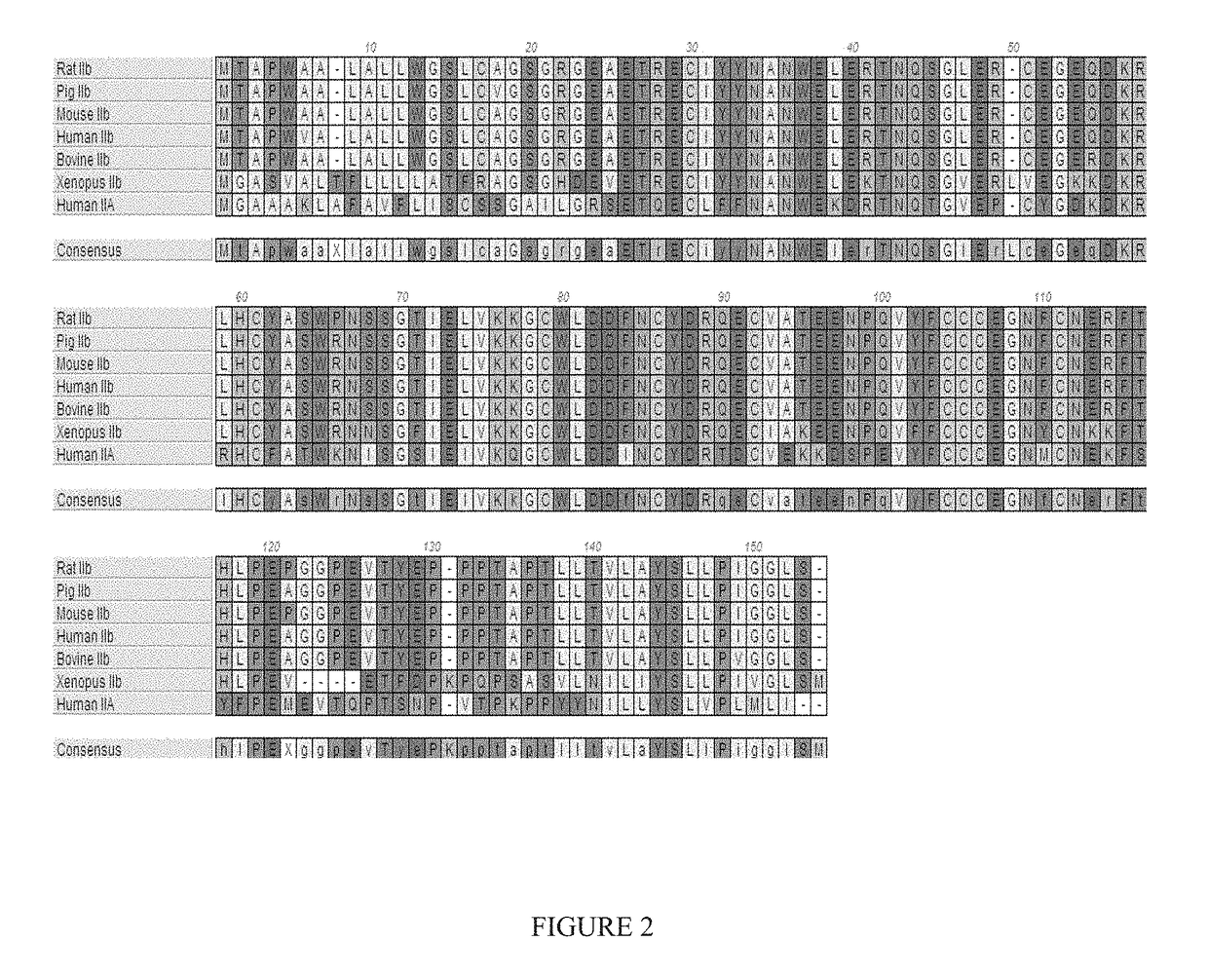Methods for treating eye disorders
a technology for eye disorders and treatment methods, applied in the field of eye disorders, can solve the problems of mild vision problems, increased oxidative stress, and ocular nerve damage, and achieve the effect of improving vision and high unmet needs
- Summary
- Abstract
- Description
- Claims
- Application Information
AI Technical Summary
Benefits of technology
Problems solved by technology
Method used
Image
Examples
example 1
c Fusion Proteins
[0359]Applicants constructed a soluble ActRIIA fusion protein that has the extracellular domain of human ActRIIa fused to a human or mouse Fc domain with a minimal linker in between. The constructs are referred to as ActRIIA-hFc and ActRIIA-mFc, respectively.
[0360]ActRIIA-hFc is shown below as purified from CHO cell lines (SEQ ID NO: 32):
ILGRSETQECLFFNANWEKDRTNQTGVEPCYGDKDKRRHCFATWKNISGSIEIVKQGCWLDDINCYDRTDCVEKKDSPEVYFCCCEGNMCNEKFSYFPEMEVTQPTSNPVTPKPPTGGGTHTCPPCPAPELLGGPSVFLFPPKPKDTLMI
[0361]The ActRIIA-hFc and ActRIIA-mFc proteins were expressed in CHO cell lines. Three different leader sequences were considered:[0362](i) Honey bee mellitin (HBML): MKFLVNVALVFMVVYISYIYA (SEQ ID NO: 33)[0363](ii) Tissue plasminogen activator (TPA): MDAMKRGLCCVLLLCGAVFVSP (SEQ ID NO: 34)[0364](iii) Native: MGAAAKLAFAVFLISCSSGA (SEQ ID NO: 35).
[0365]The selected form employs the TPA leader and has the following unprocessed amino acid sequence:
(SEQ ID NO: 36)MDAMKRGLCCVLLLCGAVFVSPGAAILG...
example 2
ization of an ActRIIA-hFc Protein
[0370]ActRIIA-hFc fusion protein was expressed in stably transfected CHO-DUKX B11 cells from a pAID4 vector (SV40 ori / enhancer, CMV promoter), using a tissue plasminogen leader sequence of SEQ ID NO: 34. The protein, purified as described above in Example 1, had a sequence of SEQ ID NO: 32. The Fc portion is a human IgG1 Fc sequence, as shown in SEQ ID NO: 32. Protein analysis reveals that the ActRIIA-hFc fusion protein is formed as a homodimer with disulfide bonding.
[0371]The CHO-cell-expressed material has a higher affinity for activin B ligand than that reported for an ActRIIa-hFc fusion protein expressed in human 293 cells [see, del Re et al. (2004) J Biol Chem. 279(50:53126-53135]. Additionally, the use of the TPA leader sequence provided greater production than other leader sequences and, unlike ActRIIA-Fc expressed with a native leader, provided a highly pure N-terminal sequence. Use of the native leader sequence resulted in two major species ...
example 3
ve ActRIIA-Fc Proteins
[0372]A variety of ActRIIA variants that may be used according to the methods described herein are described in the International Patent Application published as WO2006 / 012627 (see e.g., pp. 55-58), incorporated herein by reference in its entirety. An alternative construct may have a deletion of the C-terminal tail (the final 15 amino acids of the extracellular domain of ActRIIA. The sequence for such a construct is presented below (Fc portion underlined) (SEQ ID NO: 39):
ILGRSETQECLFFNANWEKDRTNQTGVEPCYGDKDKRRHCFATWKNISGSIEIVKQGCWLDDINCYDRTDCVEKKDSPEVYFCCCEGNMCNEKFSYFPEM
PUM
 Login to View More
Login to View More Abstract
Description
Claims
Application Information
 Login to View More
Login to View More - R&D
- Intellectual Property
- Life Sciences
- Materials
- Tech Scout
- Unparalleled Data Quality
- Higher Quality Content
- 60% Fewer Hallucinations
Browse by: Latest US Patents, China's latest patents, Technical Efficacy Thesaurus, Application Domain, Technology Topic, Popular Technical Reports.
© 2025 PatSnap. All rights reserved.Legal|Privacy policy|Modern Slavery Act Transparency Statement|Sitemap|About US| Contact US: help@patsnap.com



